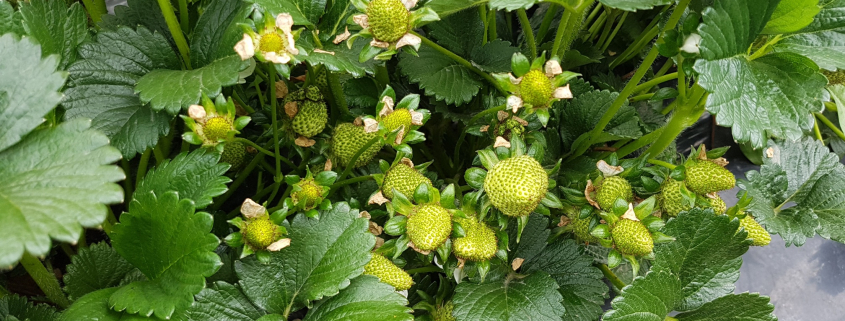Early Strawberry Nutrition Guidelines
Strawberries are a high value crop and fruit quality is absolutely paramount as growers know. What happens pre-flowering has a large influence on crop yield and quality so the importance of pre-plant & early crop nutrient management cannot be understated.
Pre-planting – Before planting you need to ensure your soil pH and calcium levels are optimal. Low pH will reduce availability of phosphorous and molybdenum and has potential to cause toxicity issues (eg. aluminium). Ideally aim for a pH (water) of 6.0-6.5 which provides good availability of most nutrients. On heavier poorly structured soils you may want to apply gypsum if not applying lime. Calcium is the most important nutrient for berry quality so you simply cannot skimp in this area otherwise you will pay the price (literally) come harvest time. Lime or gypsum should be applied well before planting (at least 3 months) though the full benefit will likely not be seen for at least 12 months following application.
On lighter soils the application of compost or animal manures can be most advantageous as they provide nutrients as well as organic carbon, that will enhance nutrient and moisture retention during the season. Organic nutrient forms are released more slowly than conventional mineral fertilizers so manures/composts will still need to be supplemented with mineral sources in most situations. Pre-plant rates of 50 kg/ha of each major nutrient (NPK) should be sufficient on most soil types.
Transplanting – This is a critical time and plants often suffer transplant shock during the first week and root uptake of nutrients is usually restricted. This is a good time to foliar feed the bushes to supplement reduced soil nutrient uptake. Complete nutrient sprays such as VLP are ideal in this situation while LIG-POLYPHOS also helps stimulate root development. LIG-KELP contains growth stimulants that also aid recovery from transplant shock.
Early Vegetative Development – This is an important phase where you are preparing the bush for flowering and fruit production. If correct nutrient inputs and balance are not maintained, it is very difficult to rectify once flowering begins. While major nutrients such as nitrogen, phosphorous and potassium are important for vegetative growth (see CR NPKomplete), calcium, magnesium and trace elements are equally important for bush health. New growth requires significant amounts of calcium (for cell walls) and this is one reason why excessive nitrogen causes calcium deficiency in fruit. Calcium is also critical for reproduction/flowering so levels need to be maintained right through the growing season, but it is essential to push hard with calcium pre-flowering to build robust bushes that can maintain good levels of fruit production. Calcium nitrate is a good option and can be used in conjunction with our control release equivalent (see CR CAL-NIT + Boron). Also be mindful of nutrient balance as calcium is immobile in the soil and excessive levels of nitrogen, potassium and magnesium can induce deficiencies.
Trace elements are essential for growth (photosynthesis) and plant health (low levels can reduce disease resistance). Zinc is especially important for early growth & deficient plants will be stunted and weak. LIG-TRACE is a fully chelated foliar trace spray ideally suited for crop establishment. Boron is another critical nutrient for strawberry production due to its role in flowering, calcium uptake and sugar transport. A combination of both soil (Calcium + Boron PLEX) and foliar (LIGNO-BORON) application will provide the best results.
On lighter soil types the addition of humates can aid fertilizer efficiency and stimulate microbial activity in the soil. LIG-HUMATES is extensively used in strawberry production in South East Queensland with excellent results & contains high levels of organic carbon (16%). With regard to nitrogen management, humates slow down nitrate release from urea leading to a better soil nutrient balance, controlled vigour and reduced leaching losses.
Here is some information on the role of essential nutrients in strawberry production.



Leave a Reply
Want to join the discussion?Feel free to contribute!